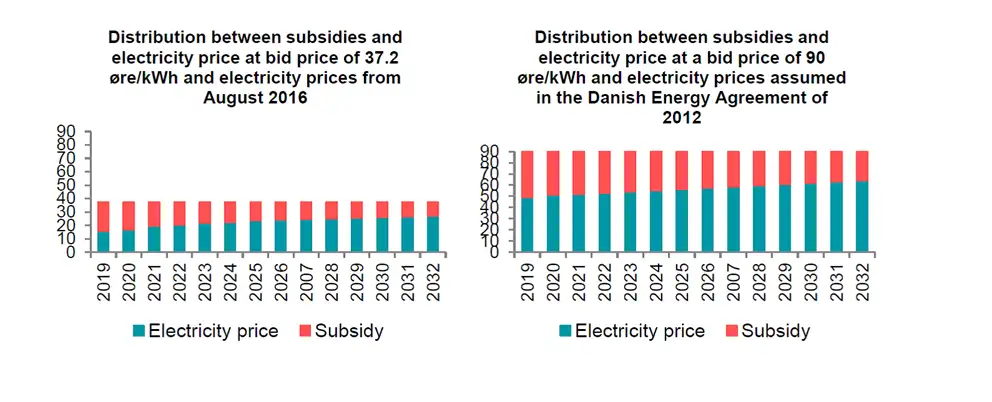This morning, Danish Minister for Energy, Utilities and Climate, Lars Christian Lilleholt, briefed the parties behind the 2012 Energy Agreement (the Red-Green Alliance, the Socialist People's Party, the Danish Social Democrats, the Danish Social-Liberal Party, the Danish People's Party, the Conservative People's Party of Denmark and the Liberal Party of Denmark) that Vattenfall has submitted the lowest bid to construct the 600 MW Kriegers Flak offshore wind farm at a tender price of 37.2 øre/kWh. There was extremely fierce competi-tion in the bid for Kriegers Flak, and in addition to Vattenfall, five other companies/consortia have been able to submit tenders. The other bids will not be published.
Costs of state aid much lower than expected
The total aid costs to construct Kriegers Flak are expected to amount to DKK 3.5 bn. for the full aid period from 2019-2032. The expected costs of state aid are around 60% less than the expected costs of DKK 8.2 bn. for the whole aid period that were forecast when the Energy Agreement was established in 2012, see figure 1 below. In addition there are costs of routing onshore of DKK 3.1 bn.

The result of the tendering round shows that the need for aid has fallen compared with expectations when the Energy Agreement was established in 2012. Expected electricity prices have fallen significantly, but as the tender price is also lower, it is expected that overall costs of state aid will also be less, see figure 2 below.

The Danish Government will complete Kriegers Flak
“Today we are making history, and Denmark is cementing its position as a global showcase and leading country for offshore wind power. The price of wind power from far out to sea is plummeting and offshore wind power has become more competitive. The government can see a number of advantages in completing Kriegers Flak. State aid for Kriegers Flak is far less than expected in the Energy Agreement, in sharp contrast to nearshore wind turbines for which aid costs have increased significantly. Kriegers Flak will link the Danish and German electricity systems and bolster security of supply of green electricity on Zealand. Kriegers Flak will provide Denmark with more than just an offshore wind farm that can supply more than 600,000 households with green electricity, it will also be an important electricity highway to other countries which takes an important step towards a more integrated European electricity market to benefit cost-effective, green and secure energy supply. All in all, Kriegers Flak is a showcase for what Denmark can do with green energy,” said Lars Christian Lilleholt, Minister for Energy, Utilities and Climate.
The final decision regarding the tender will be clarified when Treaty-compatible financing has been found under the PSO negotiations.
Facts
- The offshore wind farm is to be erected in the Baltic Sea at Kriegers Flak, east of the island of Møn, and the shortest distance to the coast is about 15 km.
- Kriegers Flak offshore wind farm will be the largest offshore wind farm in Denmark and the Baltic at 600 MW. The offshore wind farm will be constructed between 1 January 2019 and 31 December 2021.
- Kriegers Flak can generate electricity corresponding to the annual consumption of more than 600,000 households. When fully in operation, the offshore wind farm will increase the share of electricity production based on wind power by seven percentage points.
- The tender price of 37.2 øre/kWh is considerably lower than all other prices globally. The lower prices are considered to be the result of a more mature market, with more suppliers and therefore more competition. There have also been advances in technology, for example larger turbines that require fewer foundations and less installation work, and are likely to have lower operating costs.
- The electricity grid connection to Kriegers Flak also links together the German Baltic 1, Baltic 2 and Kriegers Flak. This will establish the world’s first offshore electricity grid, which combines wind power with the option to exchange electricity between two countries.
- Routing onshore will cost DKK 3.1 bn. and the accompanying cross-border connection to Germany will cost DKK 1.4 bn. Grid connection will be ready so that the first wind turbines can be connected to the electricity grid from 1 January 2019. The EU is supporting the Kriegers Flak grid connection project by up to DKK 1.1 bn. from the European Energy Programme for Recovery. Energinet.dk will be responsible for routing onshore.
- The prequalified tenderers were:
- Kriegers Flak ApS (owned by Energie Baden Württemberg AG (EnBW AG)).
- European Energy Offshore Consortium (owned by European Energy A/S and Boralex Europe S.A.).
- Vattenfall Vindkraft A/S.
- Kriegers Flak Offshore Wind I/S (Statoil ASA and E.ON).
- ScottishPower Renewable Energy Limited
- DONG Energy Wind Power A/S
- Wpd HOFOR Stadtwerke München and Kriegers Flak SPV were also prequalified , but they withdrew from the tender earlier.
- Tender prices for offshore wind turbines have fallen significantly in recent years, and the bid from Vattenfall for Kriegers Flak is the lowest ever bid for offshore wind turbines globally:
- Anholt offshore wind farm (400 MW) – 105.1 øre/kWh (2010 prices)
- Horns Rev III (400 MW) – 77.0 øre/kWh (2015 prices)
- Nearshore wind turbines (350 MW) – 47.5 øre/kWh (2016 prices)
- Kriegers Flak (600 MW) – 37.2 øre/kWh (2016 prices)
- In 2015 the share of wind energy in the Danish electricity consumption amounted to 42%. In 2020 the share is expected to be about 50%.
- There are 13 offshore wind farms in Denmark today. In the Energy Agreement from 2012 the parties agreed on three further tenders. Those are: ”Horns Rev 3”, the two near shore farms ”Vesterhav North” and “Vesterhav South” and ”Kriegers Flak”.
Contact details
Head of Media Relations
Jesper Caruso
+45 4172 9184
jesca@efkm.dk
Communication Officer
Rasmus Bjørn
+45 4172 9077
rasbj@efkm.dk